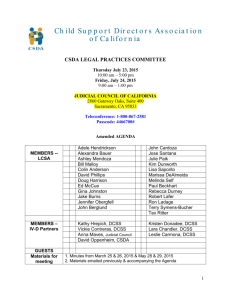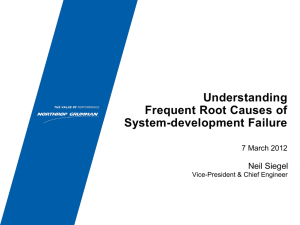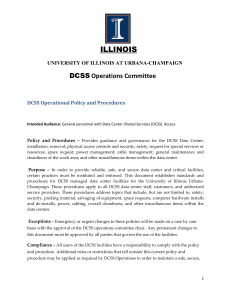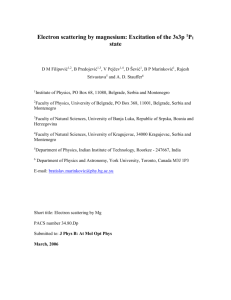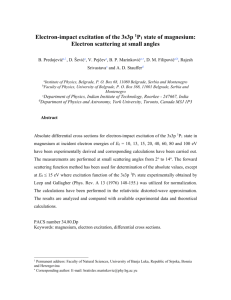Appendix-2-DCS-Provision-Lea..
advertisement
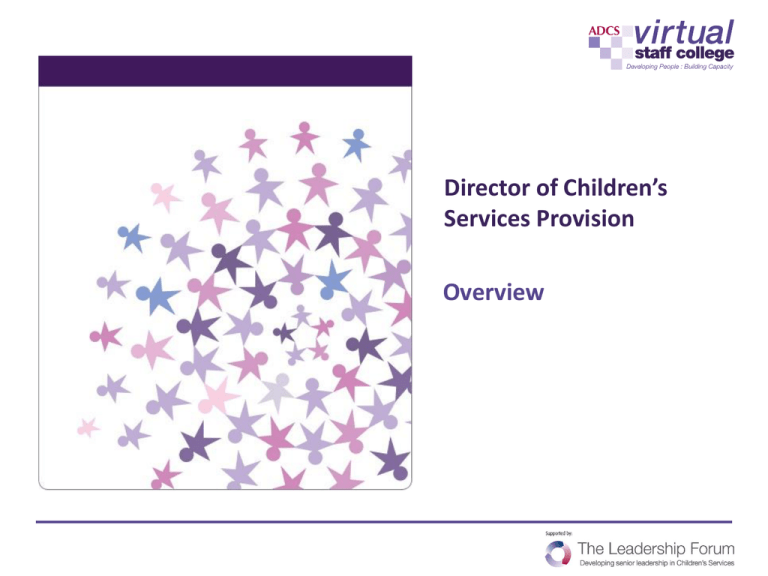
Director of Children’s Services Provision Overview Contents Context Programme aims and purpose 4 Children’s Services background 5 Origin of the programmes 6 Content 2 Overview of programmes 8 Common leadership taxonomy 9 Senior Leadership Programme for Children’s Services 21 Succession Planning 26 Black and Asian Leadership Initiative 27 Bespoke Leadership Development 28 List of acronyms 32 1. Context 3 Programme aims and purpose The DCS provision is a collection of leadership development programmes for people leading children's services at different levels. Its ultimate aim is the same as that of the leaders it supports: “...to deliver improved outcomes for children and young people...” It works towards this goal by providing those who lead children’s services in local authorities with support in balancing the complex challenges of the role, and managing both themselves and their teams. It promotes an adaptive model of leadership which is able to cope with a rapidly changing political landscape and address persistent social issues. In doing so, it is creating a common language in the sector for discussing leadership challenges, and supporting DCSs and senior leaders in children’s services as they lead their authorities through changing political and financial climates. This common understanding, coupled with the networking opportunities the programme provides, connects DCSs and senior leaders in children’s services from different backgrounds, authorities and geographies, allowing them to support each other and share experiences and best practice. 4 Children’s Services background The DCS role was created by the Children’s Act (2004), to have statutory responsibility for the education and social care functions in local authorities. An important aspect of the role is the coordination of the actions of multiple agencies to ensure that children are protected and able to develop and grow. The act was the culmination of a series of legislative changes, made in part due to several high profile failures in the child protection system. In particular, the death of Victoria Climbié was the catalyst for the Laming enquiry: a wide-ranging report into the failures of multiple agencies to protect Victoria, and wider problems in the system. In 2010, the Munro Review re-examined the state of Children’s Services and made a range of recommendations, in particular the removal of bureaucracy and ‘compliance’ and a shift towards learning and continuous improvement of practice. The report was widely praised, and DCSs and their teams are now digesting these recommendations and understanding how they can be applied within their authorities. 5 The origin of the programmes Motivation The complexity of the role, coupled with its sensitivity, led to the creation of a leadership development programme aimed at serving and future DCSs, under the then Education Secretary, Ed Balls. Though such a programme was already envisaged by the government, the emergence of the ‘Baby P’ case and the ensuing media interest prompted decisive action. Early delivery Responsibility for the provision was given to the National College for School Leadership, which took on a newly expanded remit for Children’s Services. Deloitte was engaged as a strategic partner for both design and delivery of the new provision initially from 2009 and in June 2009 the first cohort of 24 serving DCSs began on the Leadership programme. A separate programme for Aspirant DCSs was launched in April 2010. The Aspirant DCS programme has now evolved into the Senior Leadership Programme for Children’s Services. Moving away from the National College In 2010, the Coalition government reviewed the National College’s remit, which returned to focusing on School Leadership. As such, a new administering body was sought to deliver the provision on an ongoing basis. The Virtual Staff College (VSC), the training arm of the Association for Directors of Children’s Services (ADCS), was initially granted interim responsibility for the provision up to March 2012 and was then awarded the contract to deliver the provision until 2015. 6 2. Content 7 Overview of programmes 8 A common leadership taxonomy Since 2009, the leadership programmes have developed a common framework (or taxonomy) of core leadership development concepts, in order to embed a consistent approach to leadership across the sector, and across all levels of management. The aim of the framework is to provide leaders with a toolset for dealing with wicked issues: complex issues for which there is no known solution and which cannot be truly solved. The programme promotes adaptive leadership, as an approach to managing wicked issues: the ability to constantly change both one’s personal leadership style and chosen approach to ensure the best outcome possible. Other core concepts include: • public value and the strategic triangle • first 90 days • immunity to change • courageous conversations • personal resilience These concepts form the basis of the Senior Leadership Programme for Children’s Services. While these core leadership concepts that have underpinned the provision to date remain critical to DCS, the core DCS residential will introduce new concepts of leadership which build upon the adaptive leadership content previously covered. An overview of these concepts is given in the following slides. DCSs who have not previously engaged with the provision have been offered the opportunity to be exposed to the core underpinning concepts. This is not compulsory or a pre requisite of attending one of the DCS leadership residential events, however a basic overview of the core constructs will enable individuals to gain maximum benefit from the rest of the VSC provision. 9 Authority and influence - ‘To lead is to live dangerously’ (DCS core residential only) Working in a ‘productive zone of distress’, Marty Linsky’s input will introduce new leadership concepts to help DCSs make progress with real challenges faced in children’s services. DCSs will bring one key leadership challenge to the residential which participants will work with individually and collectively to make a difference to the public value they deliver. 1. Leaders and leadership – the dilemma of positional authority • Positions of authority vs. acts of leadership • What is an act of leadership in the DCS context? • The kind that surfaces conflict and challenges long held beliefs • Refresh on wicked issues and adaptive leadership 4. It’s all about impact – using systems and relationships to make progress with the leadership challenge • Understanding the impact of what you think is secret but isn’t • Work avoidance - Keeping focus on the challenge • Distinguishing role from self • Seeking sanctuary 10 Key contributor: Marty Linsky 2. Understanding the danger of leadership - knowing where to start when there is no obvious starting point and no stopping point • Understanding what’s at stake when leading and what makes it dangerous • Recognising that loss is at the heart of the challenge • Identifying factions • Working from the balcony and recognising different types of resistance 3. Being steady and ready – steady to take acts of Being steady and ready – steady to take leadership and ready for resistance acts of leadership andthe ready for the resistance • Recognising managing ‘chimes’ or Recognisingand and managing your your ‘chimes’ or ‘triggers’ ‘triggers’ • Giving thethework back Giving work back • Owning your part in the problem Owning your part in the problem • Moving from blame to contribution Moving from blame to contribution A common leadership taxonomy – wicked issues Issues can be classified as critical, tame or wicked based on two criteria: knowledge of the solution, and the leadership style required to tackle them. Increasing uncertainty about solution to problem LEADERSHIP WICKED Ask questions MANAGEMENT TAME Organise process COMMAND CRITICAL Provide answer COERCION Hard power CALCULATIVE NORMATIVE Soft power Increasing requirement for collaborative resolution Clumsy solutions If an issue is wicked, it cannot be completely solved. As such, leaders should seek to create incremental change through a series of ‘clumsy’ solutions, which each contribute to tackling a specific aspect of the issue. Clumsy solutions should be kept under review and must evolve or be replaced as the issue itself alters over time Wicked issues are those for which no known solution exists; and for which leaders must not assume that they have all the answers. They must empower their team to deliver, and should accept the continual review and refinement of ‘clumsy’ solutions as a valid way of tackling wicked issues. This approach requires the implementation of an adaptive leadership approach 11 Key contributor: Keith Grint A common leadership taxonomy – adaptive leadership Get on the Balcony • A place from which to observe the patterns in the wider environment as well as what is over the horizon (prerequisite for the following six principles) Identify the Adaptive Challenge • A challenge for which there is no ready made technical answer • A challenge requiring the gap between values, beliefs, attitudes and behaviours to be addressed Create the Holding Environment • May be a physical space in which adaptive work can be done • The relationship or wider social space in which adaptive work can be accomplished Cook the Conflict • Create the heat • Sequence & pace the work • Regulate the distress Maintain Disciplined Attention • Work avoidance • Use conflict positively • Keep people focussed Give back the work • Resume responsibility • Use their knowledge • Support their efforts Protect the voices of Leadership from below • Ensuring everyone's voice is heard is essential for willingness to experiment and learn • Leaders have to provide cover to staff who point to the internal contradictions of the organisation 12 Key contributor: Irwin Turbitt A common leadership taxonomy – strategic triangle The concept of the strategic triangle is based on the idea that, where private sector leaders seek to maximise financial profit, public sector leaders look to maximise public value. Leaders have three factors to consider when assessing the public value of an activity or initiative: 13 1. Public value proposition: whether the activity would be valuable, effective or beneficial 2. Authorising environment: whether it will receive support/sponsorship from key stakeholders 3. Operating capacity: whether the delivery team has the capacity (time, budget) to deliver it effectively Key contributor: Irwin Turbitt A common leadership framework – first 90 days (Michael Watkins) The First 90 Days provides a roadmap for creating a 90-day transition plan, supporting individuals in their transition into a new leadership role. At the heart of this roadmap sit 10 key transition challenges. Succeeding in meeting these core challenges enables a successful transition. Failure to surmount any one of them can be enough to cause potentially crippling problems. 1. Promote yourself: making the mental break from your old job and 6. preparing to take charge in the new one. Perhaps the biggest pitfall you face is assuming that what has made you successful to this point in your career will continue to do so. 2. *Accelerate your learning: you need to climb the learning curve as 7. fast as you can in your new organisation. You have to be systematic and focused about deciding what you need to learn and how you will learn it most efficiently. 3. Match strategy to situation: you need to diagnose the business 8. situation accurately and clarify its challenges and opportunities.. A clear diagnosis of the situation is an essential prerequisite for developing your action plan. 4. *Secure early wins: early wins build your credibility and create 9. momentum. They create virtuous cycles that leverage the energy you are putting into the organisation to create a pervasive sense that good things are happening. 10. 5. *Negotiate success: you need to figure out how to build a productive working relationship with your new boss and manage his or her expectations. Crucially, it means developing and gaining consensus on your 90-day plan. Achieve alignment: figuring out whether the organisation’s strategy is sound, bringing its structure into alignment with its strategy and developing the systems and skilll bases necessary to realise strategic intent. *Build your team: your willingness to make tough early personnel calls and your capacity to select the right people for the right positions are among the most important drivers of success during your transition. *Create coalitions: your success will depend on your ability to influence people outside your direct line of control. You should identify whose support is essential for your success, and figure out how to line them up on your side. Keep your balance: in the personal and professional tumult of a transition, you will have to work hard to maintain your equilibrium and preserve your ability to make good judgments. Expedite everyone: you need to help everyone in your organisation – direct reports, bosses and peers - accelerate their own transitions. The benefits to the organisation of systematically accelerating everyone’s transitions are potentially vast. *Extracts from Michael Watkins, The First 90 Days 14 Key contributor: Adam King A common leadership taxonomy – immunity to change Dealing with adaptive challenges in pursuit of public value requires individuals to reflect on their own practice and set goals for improvement, whether consciously or unconsciously. Frequently, these personal changes are not achieved; we place a series of both spoken and unacknowledged barriers in the way: our immune system Guided by tools such as the four column exercise (example below), we can analyse the big assumptions that are preventing us from achieving our goals. The objective is then to overturn the immune system, and reach a point where change becomes natural and unconscious - moving from being unconsciously immune via conscious intervention to being unconsciously released. 1: Observe the big assumption 15 2: Stay alert to natural challenges 3: Write the big assumption’s biography Key contributor: Anne Nagle 4: Design a first test 5: Examine the results 6: Run further tests 7: Consolidate your learning A common leadership framework – Courageous conversations (David Whyte) David Whyte uses ‘the three marriages’ to develop confidence and skills in having courageous conversations and coping with the pressures of adaptive leadership. Courageous conversations considers the familiar themes of integrity amidst besiegement and finding opportunities where you have written something off. An increasingly important part of this is to emphasise the invitational part of conversation, and that there is no vulnerability Courageous conversations is a tool to enable participants to: without an invitation. This leads in to • Acquire greater understanding of personal strengths and action planning, request the group do weaknesses and awareness of what individuals can bring into real work and practice the concepts the act of leadership presented by designing an activity • Understand the nature of courageous conversations and how around the importance of they can benefit you both professionally and personally vulnerability and offering people the • Improve customer focus and service through courageous invitation to vulnerability. conversations • Understand and appreciate the diversity of the individuals that make up the team • Effectively manage competing stakeholder demands • Retain talented staff by recognising their value 16 Key contributor: David Whyte A common leadership taxonomy – personal resilience Focusing on personal health and management of stress can both improve wellbeing and enhance performance in the workplace, especially in crisis situations and in dealing with difficult relationships. A series of simple exercises can be followed to help control heart rate, manage stress and increase concentration, such as: • A model for emotional intelligence Calmness and security Cognition • Senses Brain • Selfleadership Will Metabolism Limbs Strength and confidence 17 Emotion Heart Lungs Care and appreciation Key contributor: Dr Peter Gruenewald • Suspending judgement: similar to the balcony concept, focus on listening whilst avoid judgement, allowing you to recognise the other person’s feelings, needs and intentions, and consider your own responses objectively Creating coherence: focus on activating positive emotions Review: reflect on interactions objectively without concentrating on the content of the conversation, starting again if the feeling of calm coherence is lost. In-step technique: a process of critically analysing past events in order to frame better responses to future situation.
